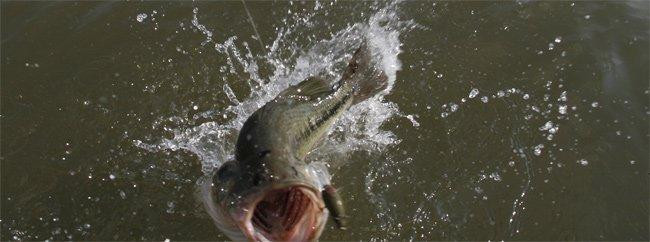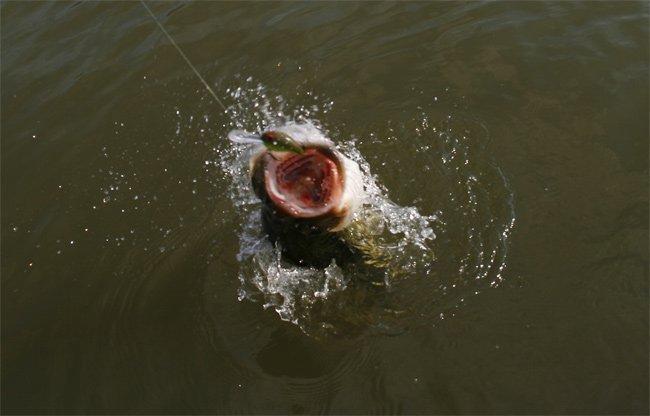The water curved around the log, creating a rim of glistening current as it rebounded off the solid structure. To the other side a glassy window showed a few boulders and some grass under the surface of the slack. The jig landed reticently in the still waters as the angler closed the bail quietly on the spinning reel. The current grabbed his line as he raised the rod tip to escape its tow. Slowly scratching the surface of the pebbles, the jig inched closer to the log.
The invisible line suddenly became visible as it popped off the surface like a small damsel fly startled by an approaching predator. The line snapped tight and began redirecting into the current. The rod loaded under the catapulting upward snap and a big smallmouth leapt out of the water froth with anger that his prey was fighting back.
Wading creeks as a kid was always somewhat akin to living the life that Hemmingway described in his short stories. There was a beauty and a romance to the trickery, conflict, struggle and reward of each cast and catch. But the real allure for me was “being first” to that untapped hole in the river. I’m not talking about a specific fishing hole but the next “piece” of the fishing puzzle that no one else had found that day, that week, that month, that season “¦ yet.
I learned at an early age that knowing a good spot was not nearly as effective as knowing when a spot was good. Moreover knowing a new spot had just become a prime ambush place for foraging fish was even the better. I would often wade and canoe streams with other anglers and it was always an adventure to be the one who figured out the next rock, the next log, the next pattern to run down the length of that day’s trip on the river that made the fishing such an enjoyable experience.
That one small piece of fishing wisdom has carried with me 25 plus years and led me to many great catches on many different fisheries. There are always popular ways to catch fish on any given fishery at any given season of the year. In the winter, everyone might be chasing bass with jerkbaits and small jigs. In the spring, the soft stickbaits and sight fishing might be the hot ticket. Later that summer, soaking worms and burning crankbaits might be the magic pill to load a boatload of bass.
But following the masses and listening to dock talk, can also cause more anglers than not to miss the boat entirely so to speak on some of the best fishing on the lake.
It seems to me bass are always about to be in transition. About the time winter really sets in, the days start getting longer and those occasional warm sunny days and warmer rains suddenly make the shallows a little bit warmer. I can’t tell you how many big bags I’ve had finding those warm runoff creeks in the early prespawn period. The same thing happens in the late summer. Everyone is out deep fishing, and you slide up to some flooded grass or shallow stump-laden flat and find it teaming with feeding bass that moved shallow to enjoy the ample forage and higher oxygen levels.
In the fall everyone is probing the backs of the creeks when fish are suspending off channel swings getting away from the flats of forage.
No one can tell you when to go do this because that is the nature of “being first” in fishing. You’ll switch gears and move to the next place the bass are transitioning to and hit them with a new approach totally different from what had been catching the fish. Some seasoned anglers would say it’s instinct, to go with your gut when you get those feelings. That’s just a slang way of saying tap into your years of experience when you found the fish on a pattern no one else was looking for yet.
A recent example came last week, and got the juices flowing for that same discovery enlightenment I felt as a teenager, chasing bass in those small creeks back home with my school chums.
Everyone knows how powerful The Alabama Rig and subsequent knockoffs have been at catching bass through the fall and winter. Most folks fail to realize its success has been because the fish have suspended from October to February thanks to one of the most unseasonably warm winters on record. In essence, we’ve had four or five months of fall in a large part of the country.
Everyone and their brothers are throwing castable umbrella rigs of some sort on every point, hump, ditch, steep bank, bay and ledge they can find – us included. We make no declarations of allegiance for or against the new castable umbrella rig craze in bass fishing started by Andy Poss of The Alabama Rig. We’ve caught piles of bass between 5 and 8 pounds since October on the rigs. No doubt they work.
But what we’re even more elated about is the fact they have left a bunch of bass unmolested in a bunch of places. We’ve thrown the umbrella rigs as much because folks bragging about big strings as we have because of our own successes. That can lead you down the wrong path because you quit trying to be first with your fishing.
The lake had some current in it last week, and the water clarity was stirred up and muddier than usual although I wouldn’t call it muddy by normal standards. I threw The Alabama Rig and the Yumbrella a bit that day, and honestly the fish had moved on me were not biting either one where I fished. I changed up swimbait configurations and still didn’t have a bump. Obviously I must not be around the fish right?
As I approached a secondary point, I remembered having caught some bass in the early prespawn time frame a couple years ago on a crankbait, a Bandit 300 to be exact. The point had some current wrapping around it, so I picked up the crankbait and fired a cast or two across the point from a couple different angles. On the third cast my rod bounded back and forth and I leaned back into something heavy. The fish came up and rolled and it was a nice largemouth.
After a short fight and a couple of surprising jumps in the 51 degree water, I landed the fish. I was beaming like that 15-year-old holding a big smallie from the Kings River with soaking shorts and sloppy sneakers. The fish was 5 pounds, 2 ounces and was fat and unscarred in any fashion, just a beautiful prespawn bass that had moved up in the warmer waters.
What had I found I thought? Was it a fluke? I picked the rigs back up and worked the area thoroughly, but never had another bite. So I headed up lake looking for some more productive areas. The lake water temperature had been 44 degrees a week before and not it was reading 51 on my Lowrance HDS on the front deck. I hit the next rocky bank working my rigs slowly and methodically around any rocks, stumps, brush I could feel. No bites and no takers.
As I approached the next point, I reached for the Bandit 300 again. Two casts in with the crankbait and the rod loaded again. I reared back on the rod and fought another great keeper bass into the boat weighing a little more than 4 pounds.
“I’m an idiot,” I thought to myself. The fish were up there feeding on those points, right on the bank and apparently didn’t like five big swimbaits crashing in on the party. But shoot a diminutive crankbait into the crevices of the rock and pull it out slowly, and it was easy to catch the bass. It felt just like those stream bass of my youth. Those things would bite like they’d never seen an artificial before, and I’m convinced to this day a good many of them had not until falling for mine.
I only had about a half hour to run a couple more points and was astonished to find that I had caught more than 18 pounds on a crankbait only running the pattern for about an hour total. These fish hadn’t been touched yet and I got there first. I’m sure other anglers had probably fished these areas, but not the way I was and not with what I was.
It was a good reminder that following the crowd might catch some fish, but beating the crowd to the party can lead anglers to some of the best fishing days of their life. Staying ahead of the pressure, and looking forward to the next transition for the fish. Understanding your weather variables and how that could change where the fish are feeding and holding as one season transitions to another puts a lot of fish in the boat for a lot of great anglers.












